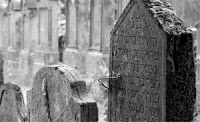In Judaism, the dead are given great respect. One important tradition that reflects the Jewish faith’s respect for the deceased is the placing of a tombstone upon the grave. From a practical perspective, the tombstone makes it possible for people to visit the burial sites, to prevent others from desecrating the grave and for those of the priestly caste (Kohanim) to avoid coming within the precincts of the dead.
While marking a grave appears to be an almost universal custom, the Jewish tradition of doing so is traced back to Rachel’s death. When Jacob led his family back from Charan and entered the Promised Land, Rachel died. Jacob had no choice but to bury her on the roadside. The Torah then describes that “Jacob set a pillar upon her grave: that is the pillar of Rachel’s grave unto this day” (Genesis 35:20).
The tombstone, known in Hebrew as a matzeiva or a tziyun, is carved from stone or granite. Although other words may be added to a tombstone, one traditionally finds the following inscriptions (in this order) on a Jewish tombstone:
 1: The Hebrew letters Pey and Nun, an abbreviation for “poh nitman,” here lies buried.
1: The Hebrew letters Pey and Nun, an abbreviation for “poh nitman,” here lies buried.
2: The deceased’s complete Hebrew name.
3: The Hebrew date of death.
4: The Hebrew letters taf, nun, tzadi, bet, and hey, an abbreviation for “Tehe nishmato/nishmata tzerurah bizror hachayim” May his/her soul be bound in the bond of life.”
The dedication* of the tombstone is often performed with a simple ceremonial gathering of close family and friends. Psalms are recited, a eulogy is delivered and prayers of mourning are said. Different communities have different customs as to when it is appropriate to place the tombstone, but it is not usually more than one year after the funeral.
*Please note that although “unveilings” are common, they are not a genuinely Jewish custom.
Copyright © 2012 National Jewish Outreach Program. All rights reserved.
Related Posts
Moses’ Impact on Jewish Life
Whether one observes the 7th of Adar as Moses’ yahrzeit (anniversary of his death) or…
0 Comments1 Minute
Life Savers
If you live in a city with a large Jewish population that has Hatzalah (Jewish EMS…
0 Comments1 Minute
 Print This Page
Print This Page